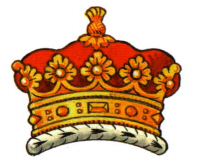
|
The Complete Guide to the British Peerage & Baronetage |
If you have found this page useful, why not make a donation to The Peerage Research Trust so that we can continue to maintain and develop Cracroft's Peerage?
____________________________________________________________________________________________________________
Dukes of England

A duke's coronet
The Dukedom, the first and highest rank in the peerage, was introduced into England as a peerage title by King Edward III. In 1337 he created his eldest son, Edward, known as "the Black Prince", Duke of Cornwall, with remainder to his heirs, being the eldest sons of the Kings of England. By this charter the eldest son of the Sovereign has become Duke of Cornwall from the moment of his birth or the accession of his parent to the Throne. The second Dukedom to be created was conferred in 1351 upon Henry Plantagenet, 4th Earl of Lancaster, under the title of Duke of Lancaster, a dignity which expired at his death in 1361 without male issue. It was conferred again the next year upon King Edward III's third son, John of Gaunt, who had married the Duke's second daughter and eventually sole heiress, Blanche of Lancaster. For more than a century after its first appearance in England, grants of the ducal style were strictly confined to near relatives of the King, either by blood or by marriage. The first subject to receive a dukedom who was not a member or close relation of the Royal Family was Sir William de la Pole, Marquess of Suffolk, who was created Duke of Suffolk in 1448.
In spite of forty creations the number of Dukes in England steadily declined until the days of the two Tudor Queens, Mary I and Elizabeth I, who between them not only did not create any new dukedoms but made matters worse by attainting three of the surviving titles, thus causing the rank to became, in the words of Blackstone, "utterly extinct" in England just at a time when, in spite of 10 creations, it had no representatives in Scotland either. This was in 1572, when the last surviving Dukedom, that of Norfolk, followed those of Northumberland and of Somerset onto the scaffold and into attainder. However the existence of the rank was revived thirty-one years later on the accession of King James I in 1603, when his eldest son Henry, already Duke of Rothesay in Scotland, became Duke of Cornwall in England under the charter of 1337. The first new creation of a duke did no come until 20 years later, when James I created the Dukedom of Buckingham for his favourite, George Villiers.
Just as the first of the eighty-four English Dukedoms was Royal, namely that of Cornwall for Edward the Black Prince in 1337, so also was the last, that of Cambridge, in 1706 for the electoral Prince of Hanover, afterwards King George II.
A non-Royal Duke is styled "His Grace" and the "Most Noble" and he is officially addressed by the Crown as "Our Right Trusty and Right Entirely Beloved Cousin". This mode of address started in the reign of King Henry IV, who through his immediate family was related or allied to every Earl in the kingdom. When a Duke or any other peer is a member of the Privy Council the word "Counsellor" is placed before his name, for instance: "Elizabeth the Second......To Our Right Trusty and Right Entirely Beloved Cousin and Counsellor, Bernard Ummayad, Duke of Norfolk.....Greeting!".
He bears also, upon some occasions, the title of "Most High, Potent and Noble Prince".
In common with all peers, Dukes are entitled to both coronation and parliamentary robes. The Coronation Robe, which, as the name suggests, is worn only at the Coronation of the Sovereign, is of crimson velvet, edged with white fur and having four rows of ermine on the white fur cape. Duchesses are entitled to wear coronation robes similar to those of a Duke, these being edged with a five inch border of white fur with a train two yards on the ground. The Parliamentary Robe of Estate of a Duke, which is worn for the State Opening of Parliament or by those taking part in the ceremony of Introduction of a new peer, is of fine scarlet cloth lined with taffeta. It is trimmed with four guards (or bands) of ermine and gold lace, and is tied at the left shoulder with a white ribbon.
Coronet - A circle of gold, surmounted by eight golden strawberry leaves; a cap of crimson velvet, turned up ermine, thereon a golden tassel.
____________________________________________________________________________________________________________
ã Copyright: Heraldic Media Limited. All rights reserved.